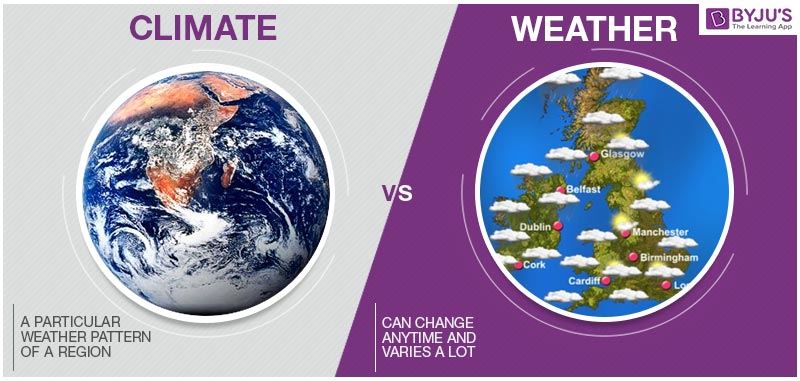The earth temperature is becoming warmer day by day. The pretty glaciers have started to melt, greenhouse gases are clouding the world, the sea levels are rising and global warming is right upon us. This condition could be even worse if we do not control it. These atmospheric conditions are extreme or intense enough which may lead to the loss of life.
Climate Vs Weather

Weather and climate are two different but related terms one must comprehend. Most of us have seen the weather report on the news dictated by the weather forecaster, speaking about the temperature, cloudiness, humidity, and whether a storm is likely to hit in the next few days and more. This is the day-to-day state of the atmosphere at a particular place.
Weather refers to the condition of a place or an atmosphere on a daily basis. It could be cloudy, sunny, rainy, stormy or clear. It is a part of the natural phenomenon which maintains the equilibrium in the atmosphere. In contrast to the weather, the climate is the long-term condition of a particular region. It refers to the average weather in a place over many years. While the weather could change in just a few hours, climate takes hundreds, thousands, even millions of years to change. However, it is changing at an alarming rate over the past few years. This explains why deserts are too hot while poles are freezing.
Factors Affecting Climate Changes
Climatic changes are the outcome of influences we had on the atmospheric factors i.e. factors that affect climate. These factors are undergoing changes over and over for a few decades. Here are a few natural factors affecting climate change.

- Topography: Refers to the shape of the land. Latitudes and elevation ranges are one of the factors that lead to fluctuation in surface temperatures. It can lead to local changes in climate.
- Sea level: One of the influential factors affecting a region’s climate is the distance from the sea and nearby water bodies. The surface temperatures in Sea have an effect on land temperatures. Coastal areas are cooler and wetter than internal areas. This leads to cloud formation when warm air from these interior areas meets cool air from the sea.
- Ocean currents: These can transfer heat energy from land to sea or vice versa, hence influencing the temperature of the region.
- Prevailing winds: Winds scatter specific air masses. The climate of a region can be dependent on the direction of the wind as the wind from the humid region could bring cool air while that from the dry region would bring hot air.
Apart from these natural factors, there is a huge influence of humans on climate changes. Climate change is remarkably induced by human activities. Deforestation, an increase in the human population, pollution caused by the burning of fossil fuels, emission from vehicles and industries are all contributed by humans, and they result in the climatic change.
Increasing the planting of more trees in our surroundings can decrease the amount of carbon dioxide in the atmosphere by the process of photosynthesis.
This is the time to think and act. Learn more about climatic changes and help mankind find a solution to this issue. For more details, visit BYJU’S.

Comments